Plextor M3 Pro (256GB) Review
by Kristian Vättö on July 1, 2012 1:45 PM ESTRandom Read/Write Speed
The four corners of SSD performance are as follows: random read, random write, sequential read and sequential write speed. Random accesses are generally small in size, while sequential accesses tend to be larger and thus we have the four Iometer tests we use in all of our reviews. Our first test writes 4KB in a completely random pattern over an 8GB space of the drive to simulate the sort of random access that you'd see on an OS drive (even this is more stressful than a normal desktop user would see).
We perform three concurrent IOs and run the test for 3 minutes. The results reported are in average MB/s over the entire time. We use both standard pseudo randomly generated data for each write as well as fully random data to show you both the maximum and minimum performance offered by SandForce based drives in these tests. The average performance of SF drives will likely be somewhere in between the two values for each drive you see in the graphs. For an understanding of why this matters, read our original SandForce article.
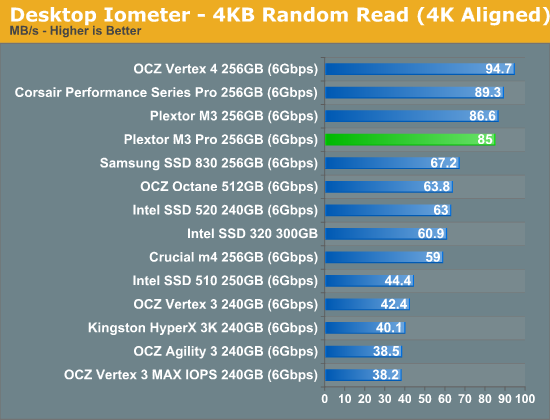
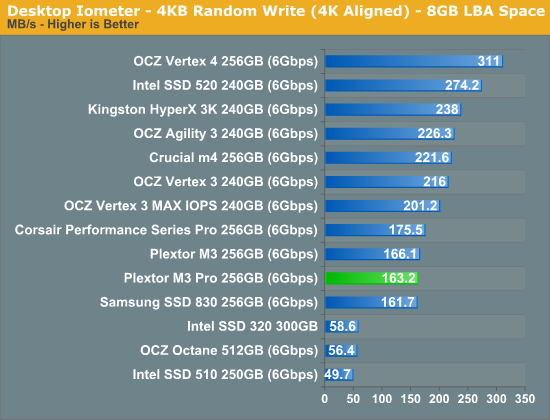
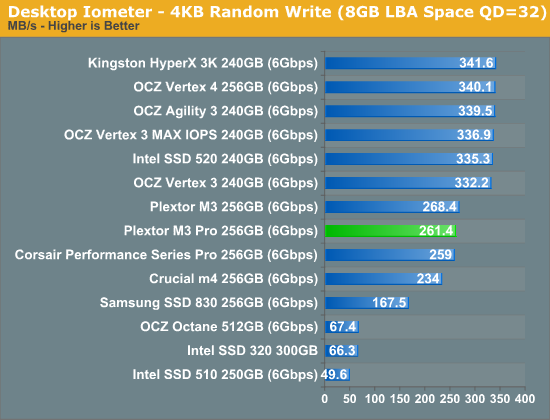
Random performance has not changed and the M3 Pro performs equally with the M3. The M3 Pro is actually slightly slower but the difference is only 1-3%, which is so small that it's within the margin of error.
Sequential Read/Write Speed
To measure sequential performance we ran a one minute long 128KB sequential test over the entire span of the drive at a queue depth of 1. The results reported are in average MB/s over the entire test length.
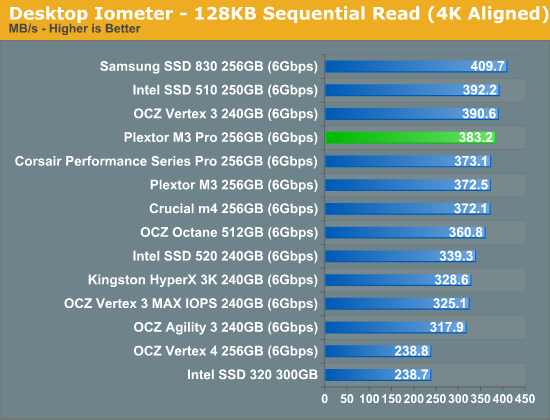
When moving to sequential read, the M3 Pro comes out as a faster drive compared to the M3. The difference is a mere 10.7MB/s, which translates to ~3%, so we aren't looking at a massive improvement here.
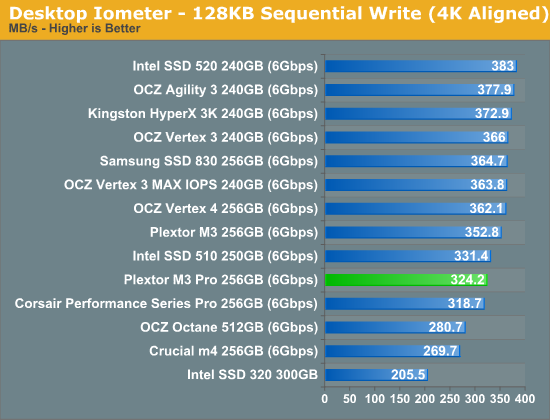
Sequential write speed turns out to be a surprise: the M3 is nearly 30MB/s (~9%) faster here. I even ran the sequential write test on the M3 Pro several times to make sure this is not an error on our end. However, it should be kept in mind that sequential write is just one aspect of performance—this doesn't mean that the M3 Pro is worse than the M3.










55 Comments
View All Comments
Coup27 - Sunday, July 1, 2012 - link
I agree. I welcome another SSD toolbox into the mix, but with its current feature set, it is largely pointless. Manual TRIM for a toolbox utility is essential.I presume that Samsung make Toshiba's NAND for them? I did not know that.
Kristian Vättö - Sunday, July 1, 2012 - link
Samsung and Toshiba both make their own NAND. Toshiba does have a joint venture with SanDisk though (similar to what Intel and Micron are doing).Coup27 - Monday, July 2, 2012 - link
"The NAND is once again from Toshiba and there are a total of eight NAND packages on the PCB. These are 32GiB quad-die packages and are manufactured using Samsung's 24nm process"I don't understand this then?
Kristian Vättö - Monday, July 2, 2012 - link
That's a typo/error. Fixed now :-)csroc - Sunday, July 1, 2012 - link
At least the author knows who Plextor is this time!pheadland - Sunday, July 1, 2012 - link
OCZ also has an SSD toolbox, and it more functionality than the Plextor one.Belard - Monday, July 2, 2012 - link
Last time I checked... its just a ROM/FIRMWARE upgrade tool.Hence, I buy and tell friends to get Intel drives. I'll gladly pay the extra $20~30 for the reliability, support and upper-class performance. Sure its NOT #1, but I'll take a slight performance hit over BSODs and full out failures.
I had to explain to a client his SSD that Dell installed in his high end Dell is a Samsung that doesn't support TRIM... its new enough to be SATA3/6Gbs - and yet its performance is already SLOWER than my own intel G2 M25 drive (SATA 2).
The Intel tool box if full featured. 3.0x is quite nice.
KAlmquist - Sunday, July 1, 2012 - link
I ask because the write performance of SSD's can vary a lot depending on how full the drive is. The Vertex 4 even uses a different block allocation algorithm if the drive is less than half full.Kristian Vättö - Sunday, July 1, 2012 - link
Storage Bench is run on a clean drive.KAlmquist - Monday, July 2, 2012 - link
So it measures how the drives perform when they have a lot of free space. Thanks.